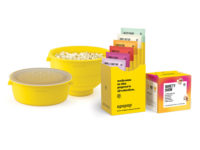Now more than ever, in the midst of a global pandemic, it is imperative for companies to have stringent maintenance and sanitation protocols, prioritizing employee safety. Luckily, many companies are upping their game, and even installing new maintenance and employee relief areas.
Stuart Jernigan, preconstruction director, A M King, Charlotte, NC, suggests looking at total separation of truckers and other vendors/suppliers from operating personnel. “That means totally separate restrooms, break areas and pass-through/work areas for paperwork. Of course, this strategy will always be dependent on function, flexibility, and cost. In new facilities, the cost should be minimal, but retrofits may or may not be depending on layout and function.”
Amanda Arnold, assistant design manager, Gray, Lexington, KY, says facility design can support maintenance and sanitation protocols in many different ways, including everything from the design of the project site to the design of the facility itself. “These design principles also include the movement of people from outside to inside the facility and the movement of people within the facility. The first barrier of defense is a deliberate site plan, which can help mitigate outside risk, followed by design elements within the facility that help prevent any risks from entering the building. The careful consideration of the circulation of employees can also help support maintenance and sanitation protocols.”
Material selection also plays an important role in maintenance and sanitation and can include anything from the material selection of the building’s structure and skin to the interior finishes or even furniture finishes, Arnold says. “A few design principles with growing importance in light of the COVID-19 pandemic are the air filtration and ventilation design, as well as the concept of creating separation between people within the facility, whether that be through physical space or the addition of barriers between workstations. Lastly, more touchless design elements can be integrated into the facility to increase the use of new health and hygienic technologies.”
The first step to designing for high sanitation operations is to hire a designer trained and experienced in food plant design, says Brandon Davis, vice president and general manager, The Austin Company, Cleveland. “We have a core focus on food and beverage design, so much so that many of our design team members are also HACCP-certified professionals. Many of our senior team members spent years operating plants before joining Austin.”
Dave Watson, project executive, baking and snack, The Austin Company, says that design standards provide the foundation for effective plant maintenance and sanitation. “A critical design task is ensuring that everything within the plant can be efficiently and effectively cleaned and maintained. The design of a plant needs to allow for easy access to motors, conveyor systems, and equipment. Hose stations and floor drains must be strategically located for equipment and systems requiring washdown.”
Airflow design is another essential factor. Directing airflow and odor away from areas that could impact a product is vital to product quality, Watson notes. “Pressurization is key. Failure to properly pressurize can cause insects, mold, and other contaminants to be drawn into the facility. Proper air filtration is also necessary to filter out any mold particles and insects that come through the HVAC system.”
Food manufacturers need to avoid many of the standard design elements found in other building types, says Watson. “Horizontal ledges, cracks, and crevasses created by panels and columns allow for dust and dirt buildup and provide insects and rodents ideal coverage. Fly fans should be located at the entrance doors and loading docks, and 18-inch rodent strips around the building’s perimeter.”
When planning maintenance for employee relief areas, a key consideration is the number of employees who will be using the area at any given time, explains Bret Zaher, Manager, Operations, AIB International, Manhattan, KS. “Old offices or storage rooms are often turned into a break area, but these are often not sufficient to accommodate the number of personnel using them at one time.”
Another important factor is to have a sink for employees to rinse their dishes out so there is little debris left over to mold or attract pests on their dishes and containers in case they get left out, notes Zaher. “Microwaves and other methods of heating food should be provided and be in sufficient numbers so employees don’t lose their entire break waiting in line to heat up their food. Appropriate ventilation and lighting need to be provided to ensure odors are controlled and that these areas are bright enough for cleaning and inspection purposes.”
Personnel locker rooms should also be sufficient to accommodate all personnel at the site, with the same ventilation and lighting requirements as break rooms, says Zaher. “These areas should be equipped with double doors to help keep odors and activities from affecting the production area. To help maintain sanitary conditions in these areas, they should be cleaned after each break for general housekeeping and deep cleaned at least monthly to help prevent pest harborage.”
Arnold says facility designs have changed as a result of the COVID-19 pandemic, adding another layer of design principles to help mitigate issues related to this pandemic—and potential future pandemics. “It’s clear that the design of breakroom and kitchen areas has changed to better meet sanitation and safety goals.”
The industry recognizes that protecting the employee goes beyond the plant floor, says Watson. “Shared spaces like break and locker rooms need to be expanded or reconfigured to allow for social distancing requirements. Airflow and UV light technology is being employed in these areas.”
Zaher says that due to COVID, many sites have doubled or even tripled cleaning of breakrooms and bathrooms. “This includes cleaning pre-shift, after each break, and at the end of the shift. Increased cleaning has included door handles, water fountains, touchpoints on the vending machines, PPE stations, hand wash stations, smock/apron storage areas, handrails, guard poles, and time clocks. Other areas of increased cleaning included laptop/computers, workstations/worktables, operator’s desks and chairs, tool and toolboxes, printer/labeler areas, and forklifts and pallet jacks.”
Operations now often sanitize PPE such as hard hats and safety glasses, as well as handheld communication devices, prior to use. Some sites have even mandated changing into new PPE after each lunch break, Zaher adds.
Jernigan says A M King has incorporated protocols that replicate CDC guidelines, including temperature checks prior to work and required PPE. “In addition, due to social distancing requirements, our facility designs are incorporating spacing techniques for plant workers in welfare areas and production lines. One example involves limited numbers of employees in locker rooms, break rooms, and toilet rooms at any given time. These techniques may include access turnstiles with digital controls for counting people in and out, temperature monitors, and retina scanning or non-contact fingerprint for identification.”
Watson says that many employees in bakeries are working in tight conditions, averaging distances of three feet apart. “This is half the CDC recommendation of six feet. Because the footprint of many existing plants can’t expand, Lexan guarding partitions are used. And, while a standard in the industry, wash stations at employee entrances are more important than ever.”
Davis says that the process for entering the plant has undergone significant change. “Employees are required to stand socially distanced and have their surface temperature taken. In current projects, we are employing an infrastructure that enables a color-coding system to screen. Green means ‘able to proceed,’ Yellow indicates a temperature above 100.3˚F. This employee is flagged as suspect and directed to a secondary station where the temperature is retaken to eliminate any concern of a faulty reading. Red signals a highly elevated temperature requiring immediate quarantine.”
Watson says that many of the things that The Austin Company has put in place during 2020 will carry into the future. “COVID has changed our lives dramatically, and I don’t think we are ever going back to where we were. Everyone is more aware of the potential of an infectious disease having a significant impact on our workforce and economy. Social distancing and laying out workstations to allow for proper spacing is going to be the norm.”
COMPANY: McCloud Services
WEBSITE: https://mccloudservices.com/
SANITATION SNAPSHOT: “We now offer a disinfection service called Disinfectix for our clients in response to the pandemic,” says Pat Hottel, technical director, McCloud Services, South Elgin, IL. “This service is carried out using products labeled for use against various pathogens and meets EPA criteria for use against SARS-CoV-2 viruses. It can be used for clients seeking large-scale disinfection services.”
Hottel says McCloud Services has been field-testing a variety of remote and electronic monitoring devices for several years. “Some of these devices have even made their way into our permanent systems offerings and we consistently research the best, new options for our clients. In particular, electronic monitors offer the option of providing notification of pest activity remotely. So, if a mouse is captured inside a facility, a sensor within the trap can alert the pest management professional by text. This provides an immediate notification, which can be helpful in analyzing the root cause of pest activity. It also allows the pest management firm to measure activity, even if a facility is closed or has restricted access due to pandemic related limitations.”
Additional new technology options include the use of added cameras or other monitoring devices that help determine pest patterns. “There are new pheromone traps and insect light traps that are currently available, both with cameras mounted inside. Images captured by these traps are used to count and trend pests caught remotely. We currently have these pheromone traps deployed in permanent installations. However, the insect light trap option is relatively new and still being tested,” says Hottel.
“We also use standalone cameras, which can send images remotely to alert us regarding rodent activity and pest travel patterns,” says Hottel. “This can help direct our efforts regarding the best locations for control device placement and for prioritizing pest proofing and sanitation efforts. Cameras can tell us more than an in-person visual inspection typically can.”
Other Features Include:
-
All pest management documentation is available electronically, enabling remote documentation reviews and audits
-
Offering a program utilizing pest pheromones for pest population control, preventing and/or delaying mating
-
One pheromone-based product can be sprayed and or fogged into an area (currently available for post-harvest control of the Indianmeal moth
COMPANY: Orkin
WEBSITE: https://www.orkin.com/
SANITATION SNAPSHOT: “During the pandemic, most of our changes have focused on keeping our customers and technicians safe while performing services,” says Benjamin Hottel, BCE, technical services manager, Orkin, LLC, Atlanta. “New sanitation protocols for us ranged from technicians wearing PPE to service the interior of businesses (masks, shoe covers, etc.), to portable handwashing stations and sanitizing vehicles regularly.”
Hottel says that the Orkin VitalClean service, launched in March 2020, was developed specifically to help facilities maintain an environment without pathogens, especially during a time of heightened awareness around virus transmission. “When applied at full strength in accordance with the product label, the disinfectant used in the Orkin VitalClean service will kill 100 percent of bacteria and viruses on hard, non-porous surfaces listed on the label, including SARS-CoV-2, the coronavirus that causes COVID-19. Our disinfectant will also sanitize (kill 99.999 percent of bacteria and viruses) on soft, porous surfaces.”
Disinfection is an important step in the cleaning routine, notes Hottel. “Pests such as cockroaches and rodents often carry bacteria that can easily be transferred to your food products. This service provides a quick and effective solution for businesses to continue operations while helping to protect their employees and customers.”
The usual chlorine dioxide product used for years to sanitize and disinfect commercial locations after pest cleanouts can sanitize and disinfect hard and soft surfaces
Orkin’s VitalClean service has the EPA’s lowest toxicity rating (Category IV), which is defined as practically non-toxic and not an irritant. It is rated “no rinse required on food contact surfaces” (Category D2) by NSF International, meaning it is approved for use in food-handling spaces to control bacteria, viruses, and mold without the need to wash/rinse the area with water after application, says Hottel.
Other Features Include:
-
Minimal environmental impact
-
Mild on skin, hard surfaces, and fabrics
-
Service can be completed in as little as 15 minutes to minimize downtime
COMPANY: Rentokil
WEBSITE: www.rentokil.com
SANITATION SNAPSHOT: “It’s more important than ever to create a healthy, hygienic food processing or preparation facility—for your employees and customers,” says Desiree Straubinger, CP-FS, market technical director, Rentokil, Reading, PA. Each food processing or preparation facility is different, and each disinfection plan will be unique to the facility.
Depending on the situation, some surfaces will be rinsed after the disinfectant is applied, waiting until the dwell time is over to ensure disinfection and safety with areas that may touch food, Straubinger comments.
“There are many high-touch contact points in a food processing or preparation facility and many that are often overlooked. Some of the most important areas to consider include places in which the employees congregate: break rooms, bathrooms, and locker rooms,” says Straubinger.
Other Features Include:
-
Provides a thorough pre-evaluation to develop a plan for the facility to evaluate the potential threats and high touchpoint areas
-
Prior to arriving on-site at the facility, the company provides a preparation checklist to help the client prepare
-
Procedures include disinfecting light switches, faucets and sinks, doors, handles, knobs, push bars, remote controls, tables, counters, drawers, hardback chairs, and buttons on machinery, as well as special and recessed contact points, including angled electronics, keypads, and handles that curve inward








